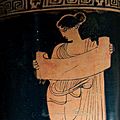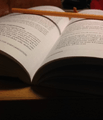Reading facts for kids
Reading is how we understand written words. It is a way to get information and ideas from books, articles, or anything written down. When you read, you understand the symbols that make up a language. You can only read if you know that language. Reading and listening are the main ways we learn new things. Reading can also be fun, especially when you read stories or jokes.
Proofreading is a special kind of reading. You do it to find mistakes in something that has been written.
Contents
How We Learned to Read Over Time
Learning to read has a long history. It started when people first invented writing. This was about 4,000 years ago!
Early Ideas for Teaching Reading
In 1570, a man named John Hart suggested a way to teach English reading. He thought people should focus on how letters (graphemes) connect to sounds (phonemes). This idea is now called phonics.
In early America, there were no special books for kids. Children often learned to read from the Bible. They also read essays about their country. Teachers did not think much about the best ways to teach reading. One very important early textbook was The New England Primer. It was first published in 1687.
Phonics and Whole-Word Methods
Phonics was a popular way to learn reading in the 1800s. William Holmes McGuffey was an American teacher. He loved helping children learn. He created the first McGuffey Readers in 1836. These books were very popular.
Later, a new method appeared. It was called the whole-word method. Thomas Hopkins Gallaudet invented it. He was the director of a school for deaf people. He taught deaf students to recognize words by showing them a word next to a picture.
In 1830, Gallaudet explained his method. He taught children to learn 50 words by sight using cards. Horace Mann liked this method for everyone. By 1837, schools in Boston started using it.
However, problems with the whole-word method soon appeared. By 1844, Boston teachers wanted to go back to phonics. In 1929, Samuel Orton, a brain doctor, said that reading problems came from the new "sight method." He wrote about this in a science journal.
Focus on Meaning and Sight Words
By the 1930s and 1940s, teaching reading changed. Programs focused more on understanding meaning. Children learned to read whole words by sight. Phonics was only taught if nothing else worked.
Edward William Dolch created his list of sight words in 1936. He found the most common words in children's books. Kids were told to memorize these words. The idea was that it would help them read faster. Many teachers still use this list today. However, some experts think learning words this way is not the best. They suggest phonics is more effective for learning words.
In 1955, Rudolf Flesch wrote a book called Why Johnny Can't Read. He strongly argued for teaching children with phonics. This book added to the big debate about how to teach reading.
Modern Reading Instruction
In the 1960s, governments started funding research on reading. By the 1970s and 1980s, studies showed that early reading depends on knowing sound-letter connections (phonics). But this research did not change how most public schools taught reading.
In the 1970s, the whole language method started. This method did not focus on teaching phonics separately. Instead, it encouraged readers to "guess" words using clues. These clues came from letters, the meaning of the sentence, and how the sentence was built. Whole language became very popular in the 1980s and 1990s.
However, whole language is now less popular. Some scientists call it a "zombie theory." This means it keeps going even without much proof that it works. Still, parts of it are used in other methods. These include sight words, the three-cueing system, and balanced literacy.
The Three-Cueing System
The three-cueing system (also called the searchlights model) appeared in the 1980s. A 2010 survey showed that 75% of U.S. teachers used it. It teaches kids to guess words using meaning, sentence structure, and letter clues. This system helps students make "better guesses." But it does not help much with harder words. It also takes away time from learning important decoding skills. Many current researchers do not support this theory. In England, a method called synthetic phonics is replacing it.
Balanced Literacy
In the 1990s, balanced literacy became popular. This way of teaching reading and writing is not always clear. It can include many things. These are word study, phonics lessons, and different ways of learning. It also includes shared reading, guided reading, and independent reading. Some people think balanced literacy mixes whole language and phonics. Others say it is mostly the whole language approach. A 2010 survey found that 68% of K-2 teachers in the U.S. used balanced literacy. Only 52% of them included phonics in their definition.
In 1996, California's education department became more interested in phonics. By 1997, they asked first-grade teachers to focus on print concepts, sounds, decoding, and vocabulary. In the U.K. by 1998, whole language was still common. But schools also started paying attention to teaching phonics in early grades.
Related pages
Images for kids
-
A reading muse
-
A volunteer reads to a girl in Mexico City.
-
Reading time at a primary school in rural Lao PDR. This school uses books from Big Brother Mouse, a group that helps kids read.
-
A Catholic monk reading in a monastery library.
See also
 In Spanish: Lectura (educación) para niños
In Spanish: Lectura (educación) para niños






















